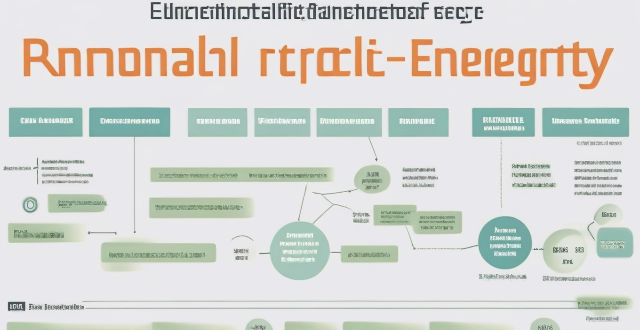Policies Energy

How do climate policies influence renewable energy development and adoption ?
Climate policies play a crucial role in shaping the trajectory of renewable energy development and adoption. These policies are designed to mitigate the effects of climate change by reducing greenhouse gas emissions and promoting the use of clean energy sources. In this article, we will explore the various ways in which climate policies influence renewable energy development and adoption. Governments around the world have implemented a range of incentives and subsidies to encourage the development and adoption of renewable energy sources. These include feed-in tariffs, renewable portfolio standards, tax credits and exemptions, and research and development funding. Carbon pricing mechanisms, such as carbon taxes and cap-and-trade systems, are designed to put a price on carbon emissions. By making fossil fuels more expensive relative to renewable energy sources, these policies create an economic incentive for businesses and consumers to switch to cleaner energy alternatives. Governments also impose regulatory measures to promote renewable energy development and adoption. These include building codes and standards, energy efficiency standards, and renewable energy targets. Public awareness and education campaigns aim to increase public awareness about the benefits of renewable energy and encourage its adoption. These campaigns promote energy conservation, support local renewable energy projects, and raise awareness about the environmental and economic benefits of clean energy sources.

How do renewable energy policies influence innovation and technology development ?
Renewable energy policies are crucial for driving innovation and technology development in the clean energy sector. These policies provide incentives for research, investment, and deployment, creating a favorable environment for technological advancements and innovation. Government support and funding, regulatory frameworks, market incentives, and collaboration and partnerships are all essential factors that influence innovation and technology development in this sector. By providing financial assistance, setting standards and requirements, creating demand for clean energy solutions, and fostering collaboration between different stakeholders, renewable energy policies help to accelerate the development of new technologies and improve existing ones. As we continue to face challenges related to climate change and energy security, it is essential that we continue to invest in renewable energy solutions and support policies that encourage innovation and progress in this field.

Can energy conservation and emission reduction policies help combat climate change ?
Energy conservation and emission reduction policies are essential for combating climate change. These policies aim to reduce energy consumption, promote renewable energy sources, and decrease greenhouse gas emissions. Improving energy efficiency and encouraging energy conservation can significantly reduce energy consumption. Increasing investment in renewable energy technologies and supporting research and development of clean energy technologies can help reduce reliance on fossil fuels and decrease greenhouse gas emissions. Implementing carbon pricing mechanisms and regulating industrial emissions are also important strategies for reducing greenhouse gas emissions. Overall, these policies play a vital role in mitigating the effects of climate change and working towards a more sustainable future.

What are the main objectives of energy conservation and emission reduction policies ?
Energy conservation and emission reduction policies aim to achieve several key objectives that are crucial for the sustainable development of our planet. These objectives can be broadly categorized into environmental, economic, and social dimensions. The main goals include reducing greenhouse gas emissions, protecting ecosystems and biodiversity, improving air quality, enhancing energy efficiency, stimulating innovation and job creation, reducing dependence on fossil fuels, promoting equitable access to energy, and raising awareness and education. By addressing these objectives, these policies play a crucial role in steering our societies towards a more sustainable future.

How can renewable energy policies be designed to maximize social and environmental benefits ?
Renewable energy policies are crucial for transitioning towards a sustainable future. To maximize social and environmental benefits, these policies must be carefully designed, considering various factors such as economic impacts, technological advancements, public acceptance, and environmental sustainability. Here's a detailed guide on how renewable energy policies can be structured to achieve the best outcomes: ## 1\. Setting Clear and Achievable Goals Clear objectives are fundamental for effective policymaking. These goals should be specific, measurable, achievable, relevant, and time-bound. ## 2\. Promoting Technological Innovation and Research Investments in research and development (R&D) are vital for advancing renewable technologies. Incentivize private sector R&D, provide public funding for research, and foster collaboration between academia and industry. ## 3\. Encouraging Public Participation and Awareness Engagement from the public is essential for the successful implementation of renewable energy policies. Educational campaigns, community involvement programs, and feedback mechanisms are key components. ## 4\. Implementing Economic Incentives Make renewable energy options more attractive through financial incentives such as feed-in tariffs, tax credits, and subsidies. ## 5\. Strengthening Legal and Regulatory Frameworks Establish clear regulations that support renewable energy adoption, including net metering laws, renewable portfolio standards, and building codes. ## 6\. Addressing Environmental Concerns Ensure that renewable energy projects minimize environmental impacts through environmental impact assessments, habitat protection measures, and sustainable land use practices. ## 7\. Supporting Infrastructure Development Invest in the necessary infrastructure to facilitate the growth of renewable energy, including transmission networks, storage solutions, and smart grids. ## 8\. Fostering International Cooperation Global collaboration is key to tackling climate change effectively. Facilitate the transfer of renewable energy technologies across borders, collaborate on international research efforts, and participate in treaties aimed at reducing carbon emissions and promoting renewable energy use globally.

What role do individuals play in achieving the goals of energy conservation and emission reduction policies ?
The article discusses the critical role of individuals in achieving energy conservation and emission reduction policies. It emphasizes the importance of individual action, highlighting the collective impact of small changes and the potential for behavioral change. The article provides various ways individuals can contribute, such as reducing energy consumption, reducing waste, supporting renewable energy, and advocating for change. It concludes by emphasizing the power of individuals to bring about change and safeguard the planet for future generations.

How do energy conservation and emission reduction policies impact the economy ?
Energy conservation and emission reduction policies have both positive and negative impacts on the economy. Positively, they create new jobs, promote innovation, improve public health, and enhance energy security. Negatively, they can increase operating costs for businesses, lead to job losses, slow down economic growth, and entail significant adjustment costs. It is crucial for policymakers to carefully consider these factors when designing and implementing sustainability initiatives.

What are the current trends in renewable energy policies globally ?
The global community is increasingly prioritizing renewable energy policies as part of efforts to combat climate change and reduce carbon emissions. Governments are offering financial incentives, setting ambitious targets for renewable energy consumption, promoting energy efficiency, and encouraging private sector investment in clean energy projects. These trends reflect a worldwide commitment to creating a more sustainable future through the adoption of renewable energy sources.

What policies are necessary to encourage the adoption of energy storage solutions ?
Energy storage solutions are becoming increasingly important in the modern world. They provide a way to store excess energy generated by renewable sources, such as solar or wind power, for use at a later time. This can help to balance the grid and ensure a stable supply of electricity....

How do renewable energy policies vary across different countries and regions ?
Renewable energy policies globally are shaped by economic, environmental, and political factors. Europe leads in renewable adoption with Germany's Energiewende, Spain's feed-in tariffs (FiTs), and Denmark aiming for fossil fuel independence. North America uses state-level RPS, tax incentives, and market-driven approaches. Asia sees rapid growth with China's government support and India's ambitious targets. Africa focuses on access to electricity through projects like South Africa's REIPPPP. Latin America balances economic development and sustainability, with Brazil expanding into solar and Mexico deregulating its electricity market. Policies include FiTs, quota systems, auctions, and financial incentives, varying by region's resources and priorities.

How do international climate agreements influence national policies on renewable energy ?
International climate agreements significantly shape national renewable energy policies by setting targets, offering financial aid and technology transfer, promoting innovation and collaboration, and creating market opportunities. This influence is evident in countries' ambitious renewable energy goals, their participation in global initiatives, and the growth of related industries. Such concerted efforts are crucial for achieving a sustainable, low-carbon future.

How effective are current climate and environmental policies in reducing carbon emissions ?
The effectiveness of current climate and environmental policies in reducing carbon emissions varies, with global initiatives like the Kyoto Protocol and Paris Agreement showing mixed results. National policies such as renewable energy targets, carbon pricing mechanisms, and energy efficiency standards have contributed to emission reductions but face political and economic challenges. Technological advances have lowered the cost of clean energy solutions. However, significant reductions require stronger governmental commitment, financial investments in green technology, and increased public engagement.

What are the economic impacts of implementing renewable energy policies ?
Renewable energy policies have both positive and negative economic impacts, including job creation, energy cost savings, reduced emissions, higher upfront costs, intermittency issues, and land use concerns. As we transition towards a more sustainable future, it will be important to carefully consider these impacts and work towards finding solutions that balance environmental goals with economic realities.

What are the benefits of implementing energy conservation and emission reduction policies in businesses ?
Implementing energy conservation and emission reduction policies in businesses can bring numerous benefits. These benefits include environmental protection, cost savings, increased efficiency, competitive advantage, government incentives, investor appeal, improved public image, job creation, and positive community impact. By adopting these policies, businesses can contribute to a more sustainable future while also enhancing their own success and growth potential.

What challenges do developing countries face in adopting renewable energy policies ?
Developing countries face numerous challenges in adopting renewable energy policies, including lack of infrastructure and technology, high costs and limited financing options, inadequate legal and regulatory frameworks, limited human resources and capacity building, social and cultural barriers, and environmental concerns and sustainability challenges. These challenges must be addressed to effectively implement and maintain renewable energy projects in these countries.

What impact does climate awareness have on global policies and decisions ?
Climate awareness has led to the implementation of various environmental, economic, and social policies at national and international levels. These policies aim to reduce greenhouse gas emissions, promote renewable energy sources, protect forests, and raise public awareness about climate change. Some examples include carbon taxes, renewable energy targets, forest protection laws, the Paris Agreement, the Kyoto Protocol, cap-and-trade systems, feed-in tariffs, tax credits for renewable energy projects, building codes, appliance standards, school curricula on climate change, and community workshops.

Can environmental subsidy policies help reduce carbon emissions ?
Environmental subsidy policies can help reduce carbon emissions by promoting renewable energy, enhancing energy efficiency, supporting waste reduction initiatives, and funding research and development of carbon capture and storage technologies. However, these policies must be carefully designed and adequately funded to avoid market distortions and ensure long-term sustainability without creating dependence on government support.

What is the public opinion on renewable energy policies and their implementation ?
Renewable energy policies have garnered significant attention as global efforts to combat climate change intensify. Public opinion is divided, with proponents highlighting environmental and economic benefits, while critics focus on costs and reliability concerns. Key aspects include: - **Support**: Backed by concerns for the environment and economic growth through innovation. - **Opposition**: Arises from perceived high costs, market distortions, and questions about renewable energy's reliability. - **Implementation Challenges**: Include technological advancements, infrastructure needs, and the necessity for consistent political support. - **Public Participation**: Education and active community involvement are crucial for building consensus and effective policy implementation.

How can governments promote energy efficiency through policies and incentives ?
Energy efficiency is crucial for sustainable development, and governments can drive it through various policies and incentives. Implementing energy efficiency standards like MEPS and labeling programs, providing financial incentives such as tax credits and grants, enforcing regulatory measures including energy audits and carbon pricing, enhancing public awareness and education, supporting R&D, and fostering international cooperation are effective strategies. These measures can lead to a more sustainable future with reduced environmental impact and increased economic benefits.

What is the role of international cooperation in shaping renewable energy policies ?
The text discusses the importance of international cooperation in developing renewable energy policies worldwide. It highlights three main benefits: sharing knowledge and best practices, accessing financing and investment opportunities, and addressing global challenges such as climate change, air pollution, and energy security. Examples are provided for each benefit, including technical workshops, research collaborations, policy forums, multilateral development bank loans, green bonds, private sector partnerships, climate change agreements, joint research efforts, and energy security initiatives. The conclusion emphasizes that international cooperation is crucial for accelerating the transition to a more sustainable and equitable energy system.

How do climate change negotiations influence national environmental policies ?
The influence of climate change negotiations on national environmental policies is significant, as they set international targets and promote technology transfer, financial support mechanisms, adaptation measures, stronger legal frameworks, and public awareness. These discussions help countries develop comprehensive policies that integrate climate considerations across various sectors, ensuring policy coherence and effective action towards global climate goals.

What role do international organizations play in promoting environmental subsidy policies ?
International organizations play a crucial role in promoting environmental subsidy policies by providing information, facilitating cooperation, offering financial support, setting standards, and engaging in advocacy efforts.

Can circular economy policies help reduce waste and pollution ?
Circular economy policies can significantly reduce waste and pollution by promoting reuse, recycling, and cleaner production methods. These policies incentivize businesses to design products that are easier to maintain and recycle, support sustainable business models like leasing and Product as a Service (PaaS), and encourage consumers to make environmentally friendly choices. Through such measures, the need for new raw materials decreases, energy consumption is reduced, and waste is diverted from landfills, all of which contribute to lower emissions and a cleaner environment.

How do environmental subsidy policies influence consumer behavior ?
Environmental subsidy policies aim to promote sustainable practices and reduce environmental harm by offering financial incentives. These policies can encourage green consumption, lower the cost of eco-friendly products, and raise awareness about environmental issues. However, they also face challenges such as insufficient incentives, unintended consequences, and limited scope and impact. Therefore, careful design and evaluation are crucial for ensuring their effectiveness in promoting sustainable development.

Can climate variability be mitigated through international agreements and policies ?
The text discusses the potential of international agreements and policies to mitigate climate variability, highlighting their roles in setting goals, promoting cooperation, creating legal obligations, and raising awareness. It also explores the impact of various policies on emission reduction, adaptation, research and development, and education. However, it acknowledges challenges such as political will, economic considerations, equity and justice, and compliance and enforcement. The text concludes that while these measures are crucial, they must be part of a comprehensive strategy that includes local efforts, technological advancements, and individual actions.

What role do governments play in implementing climate policies ?
Governments play a pivotal role in implementing climate policies by setting regulations, offering financial incentives, raising public awareness, cooperating internationally, and planning infrastructure to combat climate change.

What are the benefits of implementing circular economy policies ?
Implementing circular economy policies brings environmental, economic, and social benefits. Environmentally, it reduces resource consumption, lowers greenhouse gas emissions, and improves waste management. Economically, it creates jobs, saves costs, and drives innovation. Socially, it ensures resource security, improves public health, and empowers consumers. Overall, adopting these policies shifts towards a sustainable system that prioritizes long-term planetary health.

How do circular economy policies promote sustainability ?
Circular economy policies promote sustainability by reducing resource consumption, minimizing waste and pollution, fostering economic growth within ecological limits, creating social benefits and jobs, and encouraging systemic change and collaboration. Key practices include promoting product longevity, eco-design, zero-waste initiatives, clean technologies, circular business models, green jobs training, and multi-stakeholder cooperation. These policies aim to transition towards a more sustainable future by keeping resources in use for as long as possible while incurring the least waste.

How do environmental subsidy policies affect sustainable development ?
This topic summary discusses the impact of environmental subsidy policies on sustainable development. These policies aim to promote renewable energy, reduce pollution, conserve natural resources, and promote eco-friendly technologies through financial incentives provided by governments. However, challenges such as limited funding, inefficient allocation of funds, and unintended consequences can hinder their effectiveness. To maximize their impact, it is crucial to ensure efficient allocation of funds and consider the broader impact of these policies.

What is the future outlook for clean energy investment ?
The future outlook for clean energy investment is positive, driven by government policies, technological advancements, and growing demand for sustainable energy sources. However, challenges related to intermittency, infrastructure integration, and competition from fossil fuels need to be addressed to ensure the continued growth of the sector.